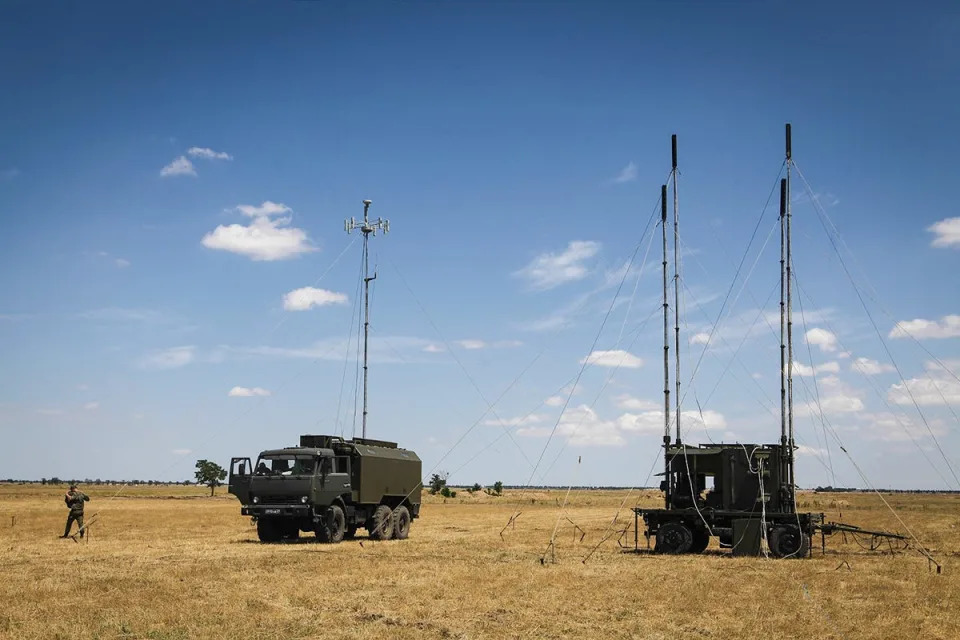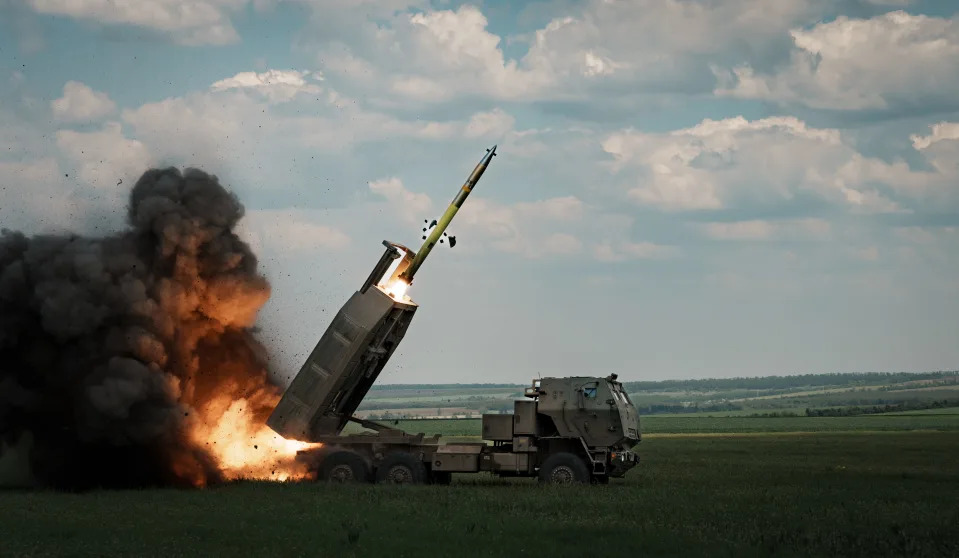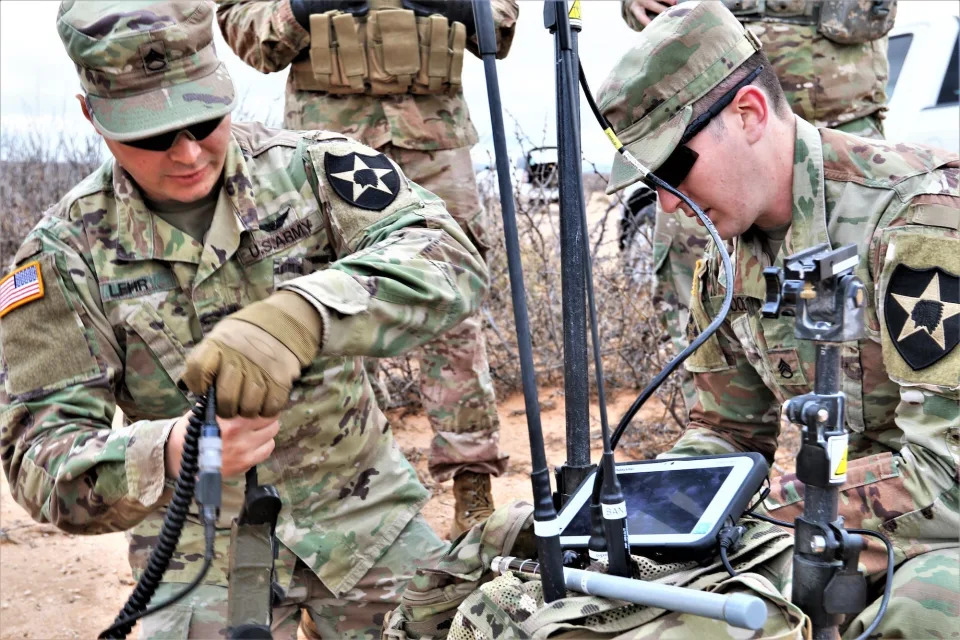-
Former US officials said the US is falling behind in its electronic warfare capabilities.
-
Russia has developed sophisticated electronic warfare weapons.
-
It's using it to neutralize US weapons given to Ukraine.
The US has been outclassed by its rivals, such as Russia, in its capacity to remotely take out enemy weapons using jamming technology, according to former US military officials.
Mike Nagata, a retired US Army lieutenant general who led special operations in the Middle East, said that the US is "still falling behind" in its electronic warfare capabilities, reported Defense One.
Electronic warfare units, which use electronic signals to remotely scramble the GPS coordinates used to guide weapons, have played a key role in Russia's war in Ukraine.
"The gap between where the United States should be and where we are, in my judgment, continues to expand not everywhere, but in far too many places," Nagata reportedly said at the SOF Week conference in Tampa, Florida. He called on the US to get more creative to regain its dominance in electronic warfare.
Two retired special operations personnel singled out Russia in remarks to the publication. They said that one reason the Kremlin's technology is significantly better, is because it ignored international laws designed to stop jamming of civilian telecommunications.
It had also invested in electromagnetic innovation for decades while the US had focused its jamming technology on gathering intelligence in areas such as the Middle, according to the publication.
Russia has repeatedly used its electronic warfare units to disable expensive precision-guided weapons that the US has given its ally Ukraine in its battle against Russia.
According to reports, they've proven effective in sending GPS-guided Excalibur artillery rounds off course. They have also been effective against the JDAM US-made missiles used by Ukraine's air force, as well as the rockets fired by US-made Himars missile systems.
Last year, Ukraine's outgoing senior commander, Valery Zaluzhnyi, in an interview with The Economist, said Russia's electronic warfare capability had given it an important edge.
The US is closely studying the conflict for information on how to improve its electronic warfare systems. In May, Defense News that the Pentagon is spending millions on developing new electronic warfare systems and technology to evade GPS jamming.
Mark Cancian, an analyst with the Center for Strategic and International Studies, recently told BI that the Department of Defense had been looking at options such as using narrower signal bands or the generation of stronger signals that are able to burn through jamming attempts.
The threats, nevertheless, "remind us to be careful about expecting 'game changers,'" he said. "The other side always develops countermeasures that reduce effectiveness."
In recent months, there have been concerns that Russia's electronic warfare units are scrambling GPS systems used by civilian planes in northern and eastern Europe, with a plane carrying the UK's defense secretary, Grant Shapps, impacted by one suspected attack in March.
Get AfriPrime Android Web View app....Click the link to Amazon app store to download https://rb.gy/3xek46
The US Air Force is teaching AI to navigate aircraft in case GPS gets taken out in a future fight
-
Electronic warfare and anti-satellite capabilities could make GPS navigation impossible in a future war.
-
The US Air Force is experimenting with using artificial intelligence as an alternative.
-
It's just one of the AI projects for the military, which also has an AI-controlled F-16 fighter jet.
In a future war, electronic warfare and anti-satellite weapons could leave the US military without GPS, a critical tool for navigation and targeting.
That challenge has prompted the US Air Force to experiment with using artificial intelligence as an alternative navigation method. It is just one of the many AI projects for the US military that could reshape warfare.
If the US were to go to war with a great power, such as China or Russia, GPS satellites and other navigation technology would likely be a primary target. Even if it were just jammed or interfered with, the result could be chaos for some American systems that rely on GPS.
A potential solution being developed by the US Air Force instead relies on AI for navigating in GPS-denied environments.
"We think we may have added an arrow to the quiver in the things we can do, should we end up operating in a GPS-denied environment. Which we will," Col. Garry Floyd, director for the Department of Air Force-MIT Artificial Intelligence Accelerator program, told the Associated Press.
Last year, the Air Force tested what it would look like to use an AI program to navigate a C-17 cargo plane via Earth's magnetic fields, a difficult method due to how electromagnetic noise from other elements, including the aircraft itself, can complicate the process. But the AI, Floyd explained to AP, was able to learn through the flight tests which signals to follow in order to direct the aircraft on where to go.
The potential for AI to be used as an alternative to GPS navigation speaks to the growing concern around GPS denial in a future fight. Much has been learned from the war in Ukraine, where both sides employ electronic warfare and GPS spoofing to jam drones and missiles, throw weapons off course, and create other challenges.
The Pentagon has long been at work on electronic warfare solutions in its joint force, developing jamming-resistant seekers and other alternatives that don't rely on GPS for coordinates. Back in August 2023, one defense official said the Army was "fundamentally reinvesting in rebuilding our tactical electronic-warfare capability after that largely left the force over the last 20 years," adding that the war in Ukraine had added "urgency" to those efforts.
Get AfriPrime Android Web View app....Click the link to Amazon app store to download https://rb.gy/3xek46
AI creates new opportunities, and the Air Force's navigation alternative isn't the only project looking into how to integrate AI into military systems. Just last month, officials announced a landmark test between an AI-piloted F-16 fighter jet and a manned jet.
While officials wouldn't reveal who won the test, which occurred September 2023, citing national security concerns, one did note that the AI program used was "progressing as well or faster than we had hoped." The use of AI raises questions though.
This week, the US and China will meet in Geneva for a major discussion on AI use. When asked about details of what AI policies, specifically those relating to reserving the right to make kill decisions and nuclear weapons deployment for humans, would be discussed at the meeting, a senior administration official told reporters that "this is the first meeting of its kind." They said that "we expect to have a discussion of the full range of risks, but wouldn't prejudge any specifics at this point."
Russia's jamming of American weapons in Ukraine is showing the US what it needs to be ready for in a future fight
-
Russia's electronic warfare has repeatedly foiled American precision weapons in Ukraine.
-
This highlights the need for the US to develop solutions before any great-power conflict.
-
Those may include different weapons, specific countermeasures, and the targeting of jamming systems.
Russian electronic warfare has created problems for some American-made precision weaponry in Ukraine, but Moscow is also showing its hand and telling the US what it needs solutions for to be ready for future fights.
Ukraine has employed US precision weapons, such as the HIMARS-fired Guided Multiple Launch Rocket Systems and air-launched Joint Direct Attack Munitions, throughout the war, but widespread Russian electronic warfare is regularly diminishing the effectiveness of these weapons.
Lt. Gen. Antonio Aguto, who's serving as the commander of Security Assistance Group-Ukraine, addressed the problem in December, saying electronic warfare directed at some of the US's "most precise capabilities" was "a challenge." Other US officials have identified these issues as well, adding that the US and Ukraine were working on solutions.
Any fixes developed to effectively counter the challenge posed by electronic warfare won't just benefit Ukraine. They're also set to help the US solve problems it has long been concerned about as it prepares for the possibility of great-power conflict.
Mark Cancian, a retired Marine Corps colonel who's a senior advisor at the Center for Strategic and International Studies, explained to Business Insider that "the widespread GPS spoofing we see in Ukraine adds urgency to solving a problem DoD has long recognized: that wartime spoofing will reduce the effectiveness of its weapons."
Get AfriPrime Android Web View app....Click the link to Amazon app store to download https://rb.gy/3xek46

Electronic warfare can be executed using cheap but effective technology, and both sides of the war are using it extensively. And these tactics are not used solely to foil precision-guided munitions. They can also be used to scramble the connection between an operator and a reconnaissance or strike drone.
Electronic warfare is a broad term that includes a variety of inexpensive options. Thomas Withington, an expert in electronic warfare and air defense who's an associate fellow at the Royal United Services Institute, said jamming was relatively straightforward, explaining to BI that it involved "blasting a GNSS receiver with noise to cause it to lose the position, navigation, and timing signal that it received from the satellite."
Spoofing, on the other hand, involves sending false GNSS information to the weapon's navigation system, sending it off course or trajectory. Jamming is easier and can be done with cheaper equipment and engineers, while spoofing is likely to be used in more specific instances, such as hiding locations from the enemy.
Both serve different purposes, but in either case, the effects can be deeply problematic for precision weaponry.
Get AfriPrime Android Web View app....Click the link to Amazon app store to download https://rb.gy/3xek46
Ukraine has managed to adapt to the challenge, in some cases, by engaging in jamming of its own or locating Russian electronic-warfare sites and destroying them. Relying on alternative systems that don't depend on GPS or use other guidance systems, such as an inertial guidance system, helps bypass the problem. That's not always an option, though.

Within the Russian military, there's probably been increased interest in employing electronic warfare in battle, especially over the past year or so, because it's so effective at countering US-provided precision weapons.
Precision systems — such as Excalibur and GMLRS, which can be fired from US-provided M777 howitzers and HIMARS, respectively — are seeing shockingly decreased accuracy because of jamming.
"The philosophy behind weapons like Excalibur and JDAMs was that their reliance on GNSS, to an extent, was supposed to provide a level of precision," Withington said.
He said the capability and accuracy of those much-vaunted weapons were now in question, adding that it "not only has tactical and operational ramifications for the Ukrainians," but it could also raise questions about "the wider confidence others have in those systems."
Daniel Patt, a senior fellow at the Hudson Institute, wrote in a statement to Congress in March that the 155mm GPS-guided Excalibur artillery shell "had a 70% efficiency rate hitting targets when first used in Ukraine" but that "after six weeks, efficiency declined to only 6% as the Russians adapted their electronic warfare systems to counter it."
Get AfriPrime Android Web View app....Click the link to Amazon app store to download https://rb.gy/3xek46
Patt added that "the peak efficiency of a new weapon system is only about 2 weeks before countermeasures emerge." That's valuable information for the US as it prepares for future fights.

The war in Ukraine has, as a defense expert previously told BI, been an "intelligence bonanza" and is giving the US an opportunity to learn how its precision weapons perform under modern threats such as electronic warfare. It's not theoretical. Instead, the US is watching a rival power engage its weapons in a real war.
Intelligence from the war builds on and probably advances years of research and discussion among US defense officials and experts about how electronic warfare would impact America's arsenal in a great-power conflict and how the US would need to adapt.
Cancian said the Department of Defense had been working on overcoming these threats by focusing on options such as using narrower signal bands or the generation of stronger signals that are able to burn through jamming attempts.
The threats, nevertheless, "remind us to be careful about expecting 'game changers,'" he said. "The other side always develops countermeasures that reduce effectiveness."
Despite the challenges, the US shouldn't completely write off its precision weapons should it one day find itself in a war with another great power, be it Russia or China, which would almost certainly employ electronic warfare as well.
Withington said that "even if that jamming has been quite successful, the tactical imperative behind this is to work out a way to outflank the effectiveness of that electronic attack," adding that while a strong Russian jamming signal might be effective, it'd also be easier to detect and destroy.
At a media event earlier this month, Doug Bush, the Army's acquisition chief, said it wasn't surprising Russia was able to jam US weapons. He said it was part of a "constant cycle" of innovation on both sides, adding that the US was learning that "with any precision weapon, you want multiple ways to guide it to its target."
For some weapons, that's already in the works. Earlier this week, the US Air Force announced a contract for add-on seekers for its extended-range JDAMs, the goal being to improve the JDAM to resist electronic jamming and instead lock onto the source of the jamming, targeting it.
Get AfriPrime Android Web View app....Click the link to Amazon app store to download https://rb.gy/3xek46
Bush said the Army had created a team focused on adapting its weapons to electronic-warfare issues long before the war in Ukraine, signaling the Pentagon's clear understanding of the problem these capabilities pose.
Bush previously said in August that the Army was "fundamentally reinvesting in rebuilding our tactical electronic-warfare capability after that largely left the force over the last 20 years" and that the war in Ukraine had added "urgency" to those efforts.

Withington said efforts to adapt precision weapons to the threat were just one facet of a multilayered solution. Other solutions to the problem involve using other weapons and prioritizing targeting the point of origin for electronic-warfare signals early in a conflict.
"It is imperative that forces like the US and its allies see future battle in a case that they have to first establish electromagnetic superiority," he said, explaining that denying enemies from using the electromagnetic spectrum in any way would "massively degrade at the very least, if not prevent altogether" an enemy from interfering with its weapons.
Get AfriPrime Android Web View app....Click the link to Amazon app store to download https://rb.gy/3xek46
Ultimately, though, as the US and Ukraine adjust to Russia's jamming and learn from the war, the "constant cycle" of innovation, as Bush said, is set to continue.
"The measure, countermeasure, counter-countermeasure that we're seeing in Ukraine is typical in war," Cancian said, adding that "no technology provides the ultimate advantage."


